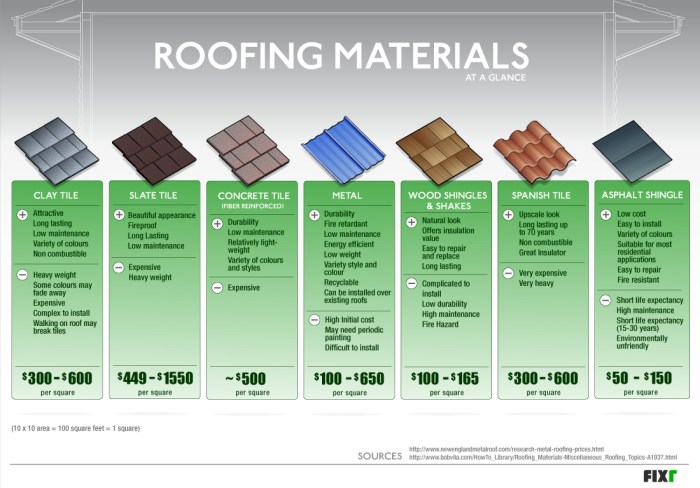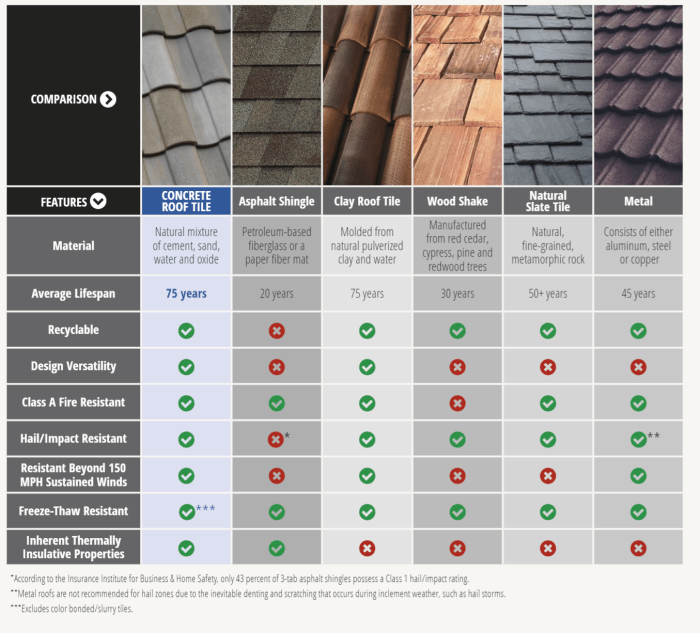Fine Homebuilding’s Top Roofing Materials Comparison sets the stage for this enthralling narrative, offering readers a glimpse into a story that is rich in detail and brimming with originality. From asphalt shingles to metal roofing and synthetic materials, this comparison explores the best options for your roofing needs.
Overview of Fine Homebuilding’s Top Roofing Materials Comparison

Fine Homebuilding’s Top Roofing Materials Comparison aims to provide homeowners, contractors, and builders with valuable insights into the best roofing materials available in the market. The article serves as a comprehensive guide to help readers make informed decisions when choosing the most suitable roofing material for their specific needs.
The Significance of Choosing the Right Roofing Materials
Selecting the right roofing material is crucial as it directly impacts the durability, energy efficiency, aesthetics, and overall performance of a building. By choosing the appropriate material, homeowners can enhance the longevity of their roof, improve insulation, reduce energy costs, and increase the property value.
Criteria Used to Evaluate and Rank the Materials
- Weather Resistance: The ability of the material to withstand various weather conditions such as rain, wind, snow, and sunlight.
- Durability: The expected lifespan of the material and its resistance to wear and tear over time.
- Energy Efficiency: How well the material insulates the building, reduces heat transfer, and helps lower energy consumption.
- Aesthetics: The visual appeal of the material and its ability to complement the overall design of the property.
- Installation Complexity: The ease of installation and the expertise required to work with the material.
Asphalt Shingles
Asphalt shingles are one of the most popular roofing materials used in residential construction due to their affordability and ease of installation. They are made of a fiberglass mat coated with asphalt and mineral granules for added durability.
Types of Asphalt Shingles
There are three main types of asphalt shingles commonly used in roofing:
- 3-Tab Shingles: These are the most basic and affordable type of asphalt shingles. They have a flat appearance with three tabs that create the look of individual shingles when installed.
- Architectural Shingles: Also known as dimensional or laminate shingles, these have a more layered and textured look compared to 3-tab shingles. They are thicker and offer better durability and wind resistance.
- Designer Shingles: These premium asphalt shingles come in a variety of styles that mimic the look of other roofing materials such as slate or wood shake. They offer enhanced aesthetics and can significantly increase the curb appeal of a home.
Pros and Cons of Asphalt Shingles
- Pros:
- Cost-effective: Asphalt shingles are one of the most affordable roofing materials available.
- Easy to install: They are lightweight and can be installed quickly by roofing contractors.
- Wide range of colors and styles: Asphalt shingles come in a variety of colors and designs to suit different architectural styles.
- Cons:
- Shorter lifespan: Compared to other roofing materials like metal or tile, asphalt shingles have a shorter lifespan of around 20-30 years.
- Prone to damage: They can be easily damaged by severe weather conditions such as hail or high winds.
- Environmental impact: Asphalt shingles are not as eco-friendly as other materials and can contribute to landfill waste.
Metal Roofing
Metal roofing materials such as steel, aluminum, and copper are popular choices due to their durability, longevity, and aesthetics. These materials offer various benefits that make them stand out in the roofing industry.
Characteristics of Metal Roofing Materials
Metal roofing materials are known for their strength, resistance to harsh weather conditions, and low maintenance requirements. Steel is a common choice for metal roofing due to its affordability and durability. Aluminum is lightweight, corrosion-resistant, and ideal for coastal areas.
Copper is a premium option known for its beauty, longevity, and resistance to corrosion.
Durability and Longevity
Metal roofing is highly durable and can last 50 years or more with proper maintenance. Compared to asphalt shingles, which typically last 20-30 years, metal roofing offers superior longevity and performance. Metal roofs are less prone to damage from wind, hail, and fire, making them a long-term investment for homeowners.
Cost Implications
While metal roofing may have a higher upfront cost compared to traditional materials like asphalt shingles, its durability and longevity can result in cost savings over time. Metal roofs require less maintenance and repair, reducing long-term expenses for homeowners. Additionally, metal roofing can increase the resale value of a home, making it a worthwhile investment in the long run.
Wood Shakes and Shingles

Wood shakes and shingles are popular choices for roofing materials due to their natural aesthetic appeal and durability. While they may look similar, there are key differences between the two.
Differentiate between wood shakes and wood shingles
Wood shakes are thicker than shingles and have a more rustic appearance due to their split and rough-sawn texture. Shingles, on the other hand, are thinner and have a more uniform look since they are sawn on both sides.
Discuss the aesthetic appeal of wood roofing materials
Wood shakes and shingles provide a timeless and natural look to a home, adding warmth and character. They come in a variety of colors and textures, allowing homeowners to choose a style that complements their overall design aesthetic.
Address maintenance requirements and sustainability aspects of wood shakes and shingles
Wood shakes and shingles require regular maintenance to ensure longevity. This includes periodic inspections for damage, cleaning to prevent mold and mildew growth, and applying protective coatings or treatments. In terms of sustainability, wood roofing materials are biodegradable and renewable, making them an environmentally friendly option compared to other roofing materials.
Synthetic Roofing Materials
Synthetic roofing materials, such as synthetic slate and rubber roofing, are innovative alternatives to traditional roofing options.
Performance Comparison
Synthetic roofing materials offer a range of benefits compared to traditional options. They are lightweight, durable, and resistant to extreme weather conditions. Synthetic slate, for example, can mimic the look of natural slate without the weight and cost associated with it.
Rubber roofing, on the other hand, is flexible and easy to install, making it a popular choice for flat roofs.
Environmental Impact and Recyclability
One of the key advantages of synthetic roofing materials is their environmental impact. Many synthetic options are made from recycled materials, reducing the need for new resources. Additionally, synthetic roofing materials are often recyclable at the end of their lifespan, further reducing waste and environmental impact.
This makes them a more sustainable choice compared to traditional roofing materials.
Wrap-Up

In conclusion, Fine Homebuilding’s Top Roofing Materials Comparison serves as a valuable resource for homeowners looking to make informed decisions about their roofing materials. With a detailed analysis of various options, this comparison ensures that you choose the best fit for your home.
General Inquiries
What is the purpose of Fine Homebuilding’s Top Roofing Materials Comparison?
The purpose is to provide readers with a detailed comparison of different roofing materials to help them make informed decisions.
Why is choosing the right roofing materials important?
Choosing the right materials can impact the longevity, durability, and overall performance of your roof.
What are the cost implications of using metal roofing?
Metal roofing can be more expensive upfront but offers long-term cost savings due to its durability.
Are synthetic roofing materials environmentally friendly?
Synthetic roofing materials like synthetic slate and rubber roofing have a lower environmental impact and are often recyclable.







